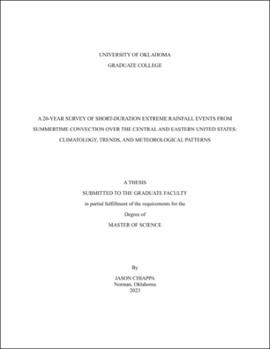| dc.description.abstract | Short-duration extreme rainfall events (EREs) caused by convection are often associated with flash flooding, which can have devastating impacts on society. An increase in the frequency and intensity of EREs has been documented over multiple continents with evidence of a direct link to anthropogenic climate change. Over the central and eastern Continental United States (CONUS), EREs peak in frequency during June, July, and August (JJA) due to the summertime maximum in convective activity, with the most significant EREs resulting from mesoscale convective systems (MCSs). These MCSs and their associated rainfall have a nocturnal maximum over the central CONUS.
This study utilizes gridded hourly Stage IV precipitation analyses to detect short-duration EREs and record their properties over the central and eastern CONUS over a 20-year period (2003–2022). The Stage IV dataset consists of gauge-corrected radar-derived quantitative precipitation estimates on a 4-km grid, which has the advantage of capturing localized extreme rainfall that can occur between rain gauge sites. Extreme rainfall is defined in this study when the 12-hour accumulation exceeded the 10-year average recurrence interval threshold at that location based on the NOAA Atlas 14 dataset. All nearby grid points simultaneously exceeding the threshold were grouped into event objects. Several spurious events that were detected due to errors in the Stage IV dataset were filtered out using consistent quality control procedures.
Results of the 20-year climatology mainly solidify previous studies, but this study provides additional quantitative evidence that nocturnal MCSs are the most prolific producers of extreme rainfall over the domain during JJA. Unfortunately, the accurate prediction of nocturnal convective rainfall has been shown to be a challenge in numerical weather prediction models. In addition, the highly localized and chaotic nature of the extreme rainfall is revealed, motivating the need for high resolutions in precipitation data and numerical models.
The few previous studies that utilized Stage IV analyses for the purposes of studying EREs did not examine interannual or long-term changes in ERE frequency or characteristics. With acknowledgments of the potential caveats of using the Stage IV dataset, this study discovered statistically significant increasing trends in ERE frequencies through the 20-year period that are dominated by MCSs during JJA, as opposed to more localized convection. Despite the short period of record, this finding aligns with previous studies suggesting an increase in heavy rainfall from MCSs in a warming climate.
This thesis also discusses the discovery of a wide range of interannual variability in the frequency and severity of the JJA convective EREs. Composite and correlation analyses using reanalysis fields reveal statistically significant large-scale meteorological patterns that may help explain this variability, which can potentially aid in medium and long-term forecasting. These patterns include higher low–mid-level moisture over the Southern and Central Great Plains, enhanced southerly moisture transport from the western Gulf Coast to the Midwest, and enhanced mid-level ridging over the southeastern CONUS. Bolstered by composite analysis of five intense nocturnal EREs over the central CONUS, there is a strong argument that the enhanced moisture transport is driven by a westward expansion of the climatological North Atlantic Subtropical High into the eastern CONUS. Higher geopotential heights over the eastern CONUS relative to the Rockies results in an enhanced pressure gradient and southerly flow over the central CONUS, leading to a stronger and/or more frequent low-level jet. The low-level jet is a key ingredient in the development of nocturnal extreme-rain-producing MCSs. However, the low-level jet observed in this study extended well to the east of the climatological low-level jet driven by the sloping terrain of the Great Plains. With studies suggesting a westward expansion of the North Atlantic Subtropical High in a future climate, the increase in intense MCS-related EREs over the central CONUS during the summer is likely to continue. | en_US |
